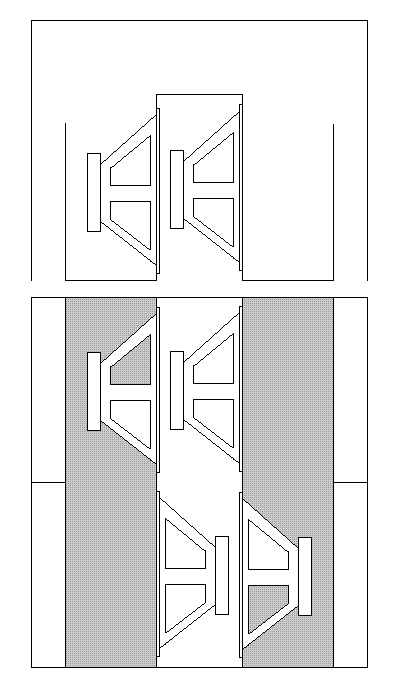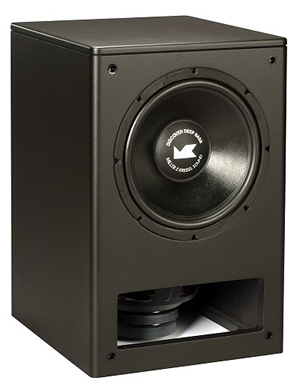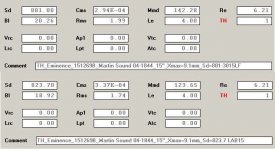PPSL in Hornresp
Hi epa,
From the efficiency viewpoint this is a bass reflex enclosure, but should have much better distortion specs. Disregard the upper peak in the SPL response, see djk's note.
http://www.diyaudio.com/forums/subwoofers/177905-thread-those-interested-ppsl-enclosures.html
Regards,
Hi epa,
From the efficiency viewpoint this is a bass reflex enclosure, but should have much better distortion specs. Disregard the upper peak in the SPL response, see djk's note.
http://www.diyaudio.com/forums/subwoofers/177905-thread-those-interested-ppsl-enclosures.html
Regards,
Pasi's comment about the seeming clone of my design:
"Obviously DJKs design. Interesting to see, that i came up with pretty similiar result without being aware of this. Great minds think alike, or how did it go"
So I guess that Ohm's HGW-10 that looks like Cowan's 10" (18Sound) horn also falls in the category "pretty similar result without being aware of this"???

Djk, I do have some questions for you. On free speaker plans you said:
“I mounted a pair of drivers in another cabinet in a face-to-face, push-push mode. The box became very 'thick' sounding and had a broad peak centered at 160hz, just like the EV MTL4. In room the response of the push-pull was 6dB smoother in the 100hz~200hz octave.”
My question is what does make the difference between the face-face and push-pull that causes this broad peak?
My second question, if two drivers in a push-pull are not perfectly aligned, say 6 degrees off, do you think this will affect the push-pull to much?
“I mounted a pair of drivers in another cabinet in a face-to-face, push-push mode. The box became very 'thick' sounding and had a broad peak centered at 160hz, just like the EV MTL4. In room the response of the push-pull was 6dB smoother in the 100hz~200hz octave.”
My question is what does make the difference between the face-face and push-pull that causes this broad peak?
My second question, if two drivers in a push-pull are not perfectly aligned, say 6 degrees off, do you think this will affect the push-pull to much?
"My second question, if two drivers in a push-pull are not perfectly aligned, say 6 degrees off, do you think this will affect the push-pull to much?"
Not speaking FOR djk, but there's talk of that here (esp 1/2 way down the page):
Speaker Plans - PPSL talk
Not speaking FOR djk, but there's talk of that here (esp 1/2 way down the page):
Speaker Plans - PPSL talk
hi djk
is it posible to model ppsl in hornresponce?
i have seen it a few times here,but never knew this type of design was so efficient,so i didn't pay attention to it.
Like tb46 said, it's possible. I didn't have much luck with it, but you're more well-versed in HR - so, you may. BassBox was much easier for me to work with. Let me know how it goes!
Their PUKK-218 is within an inch or so in every dimension of my original dual 15 PPSL.
Some of my friends are familiar with FUNKTION-ONE subs. Is it fair to compare a product/products in their line-up to your 151269 PPSL cab? From what I see, your design gives FAR more output/low end per cu. ft. and per watt. Other than that, how might I clearly compare your PPSL to FUNKTION-ONE subs and/or Turbosound TSW-218?
"From what I see, your design gives FAR more output/low end per cu. ft. and per watt. "
A 2 cu ft 2nd order sealed box with an F3 of 30hz can only be 0.18% efficient (84.55dB).
A 2 cu ft 4th order vented box with an F3 of 30hz can only be 0.36% efficient (87.56dB).
A 2 cu ft 6th order vented box with an F3 of 30hz can only be 0.90% efficient (91.54dB).
The efficiency limit for 'coupling' is about 25% with sources spaced within 1/4W.
On full-sized front-load horns you can hit 50%, I'm not sure about tapped horns. Danley (in a talk about the TH115) suggested above a stack of four that you might be better with a full-sized front-load horn.
BassBox v6.0 says four of the PPSL with the Martin #1844 will be 106.4dB/W at 50hz and play 140.2dB with 2.4KW input (-3dB at 29hz). 100% in 2Pi is 112dB, so 106dB is 25%. More cabinets will probably not increase efficiency, but the increase in power handling will increase the SPL with more power in.
A 2 cu ft 2nd order sealed box with an F3 of 30hz can only be 0.18% efficient (84.55dB).
A 2 cu ft 4th order vented box with an F3 of 30hz can only be 0.36% efficient (87.56dB).
A 2 cu ft 6th order vented box with an F3 of 30hz can only be 0.90% efficient (91.54dB).
The efficiency limit for 'coupling' is about 25% with sources spaced within 1/4W.
On full-sized front-load horns you can hit 50%, I'm not sure about tapped horns. Danley (in a talk about the TH115) suggested above a stack of four that you might be better with a full-sized front-load horn.
BassBox v6.0 says four of the PPSL with the Martin #1844 will be 106.4dB/W at 50hz and play 140.2dB with 2.4KW input (-3dB at 29hz). 100% in 2Pi is 112dB, so 106dB is 25%. More cabinets will probably not increase efficiency, but the increase in power handling will increase the SPL with more power in.
Last edited:
hi justin.
looking @ ur bassbox model it looks like its 127db ,thats 2 paralel speakers .225 ltrs tuned @33hz correct.
when i model this in winisd alpha i get only 121 db @x-max,where is the difference?
edit/ i think winisd models @4 pi
i thougth you invented a "free lunch"
looking @ ur bassbox model it looks like its 127db ,thats 2 paralel speakers .225 ltrs tuned @33hz correct.
when i model this in winisd alpha i get only 121 db @x-max,where is the difference?
edit/ i think winisd models @4 pi
i thougth you invented a "free lunch"
Last edited:
Thanks Crescendo for answering, although I was aware since I was stating from the same page. But I noticed a difference from angled settings and perfect parallel settings. But maybe it was more a matter of the box strengths/building techniques than the setup. It was a double 18” Bell in the angled style that I rebuild in a new housing using DJK’s idea. Somehow it sounded better in low end at high volumes. Of course I used the same volume and vents from the original Bell concept since I didn’t have the specs of the drivers.
I still wonder what causes the peak around 160Hz when two drivers are mounted face-to-face instead of push-push (face-to-back) mode.
Also I would like to know if there is any gain or disadvantage from using 4 drivers in one push-pull system (besides the +6 dB as result of coupling)?
I still wonder what causes the peak around 160Hz when two drivers are mounted face-to-face instead of push-push (face-to-back) mode.
Also I would like to know if there is any gain or disadvantage from using 4 drivers in one push-pull system (besides the +6 dB as result of coupling)?
i like to know this speaker,see if we can model something with that=djk on speakerplans.com says
If you were in the USA I would suggest the Eminence 151269, about 13lbs and 9.1mm x-max for $USD 65.
Epa, I think Eminence 151269 is the same as the Martin Sound 1844
http://www.martinsoundpro.com/upload/item/1844.pdf
http://www.martinsoundpro.com/upload/item/1844.pdf
Last edited:
dankje djimEpa, I think Eminence 151269 is the same as the Martin Sound 1844
http://www.martinsoundpro.com/upload/item/1844.pdf
could someone check if i got the ts right?
i got 2 differend vas nrs and no bl and sd rating
are they still availeble,how much?

100% in 2Pi is 112dB, so 106dB is 25%. More cabinets will probably not increase efficiency, but the increase in power handling will increase the SPL with more power in.
Does that mean a 109dB/2.83V/8Ω compression driver is 50% efficient? Will hornloading the compression driver increase the sensitivity and efficiency even further? Sorry for going off topic.
T/S for 151269B Martin Sound 04-1844
Hi,
This is what I came up with using Hornresp to calculate the missing values. I picked Le=4mH, and tried the Sds from the LAB15 and the 3015LF. There are some other threads out there using the same woofer, and listing a Vas=16.27ft^3 (instead of 11.5).
Regards,
Hi,
This is what I came up with using Hornresp to calculate the missing values. I picked Le=4mH, and tried the Sds from the LAB15 and the 3015LF. There are some other threads out there using the same woofer, and listing a Vas=16.27ft^3 (instead of 11.5).
Regards,
Attachments
Last edited:
tnx tb i found that tread and corrected ts in the post above.Hi,
This is what I came up with using Hornresp to calculate the missing values. I picked Le=4mH, and tried the Sds from the LAB15 and the 3015LF. There are some other threads out there using the same woofer, and listing a Vas=16.27ft^3 (instead of 11.5).
Regards,
here's Martin's old spec plus that model's spec from Eminence
01-SPEC 151269 04-DATE 03/14/95
02-PART # OBS/1844
03-MODEL # 1525F5637
05-RE OHMS 6.21 13-FS HZ 23.40
06-LE MH 4.10 14-MMS GMS 103.30
07-QM 11.63 15-CMS mm/N .4472
08-QE .350 16-RMS NS/M 1.3068
09-QT .340 17-VAS LTRS 460.63
10-XMAX MM 9.10 18-SD SCM 856.34
11-BL TM 16.42 19-EBP 66.8
12-EFF % 1.63 20-SPL dB 94.1
_____________________
15in. Bass Woofer / 15269
Made in USA &149, Santoprene Rubber Surround &149, Extra thick treated paper cone Specifications Diameter-15.187in./Impedance-8ohm/Frequency Response-20-1200kHz/Power-300W/Rms/Dc Resistance-6.21ohm/Spl-94dB/Magnet-56oz/Voice coil-2.5in./FS-23.4Hz/VAS-16.27ft3/Qms-11.63/Qes-0.35/Qts-0.34/Xmax-9.1mm/Zmax-212ohm/Depth-6.75in./Hole Cut-14in./Mounting Centers-14.75in./Weight-13lbs
"I still wonder what causes the peak around 160Hz when two drivers are mounted face-to-face instead of push-push (face-to-back) mode."
I think it is the large cavity, and the depth of the cavity. If you look at the 'planar wave horn' graphs I think you will see something similar.
"Also I would like to know if there is any gain or disadvantage from using 4 drivers in one push-pull system (besides the +6 dB as result of coupling)? "
Size might be a problem. I built some quad 12s like this:

They sounded real good and always got the 'what the h*ll is that' comment.
I think it is the large cavity, and the depth of the cavity. If you look at the 'planar wave horn' graphs I think you will see something similar.
"Also I would like to know if there is any gain or disadvantage from using 4 drivers in one push-pull system (besides the +6 dB as result of coupling)? "
Size might be a problem. I built some quad 12s like this:

They sounded real good and always got the 'what the h*ll is that' comment.
Thanks Djk, looks like I need to read a little more about planar wave horns.Hope you don't mind but I still have two questions left...
About the quad setup, I hoped for the 'only better' comment. But do you think it will also produce a 160Hz peak since two drivers are placed face-to-face (although not in line with each other)?
And my last question, if the two drivers have both a separate (independent) box but the drivers are still aligned in push-pull configuration does it still work as a push-pull system?
About the quad setup, I hoped for the 'only better' comment. But do you think it will also produce a 160Hz peak since two drivers are placed face-to-face (although not in line with each other)?
And my last question, if the two drivers have both a separate (independent) box but the drivers are still aligned in push-pull configuration does it still work as a push-pull system?
"About the quad setup, I hoped for the 'only better' comment. But do you think it will also produce a 160Hz peak since two drivers are placed face-to-face (although not in line with each other)?
The peak is from the dimensions of the cavity, and the cavity volume. Minimizing both improves bandwidth. The only negative comment I made with respect to the quad 12 was its size.
----------------------------------------------------------------------------
A small 40hz PPSL with quad 12s:
Name: Kappalite 3012LFa
Type: Standard one-way driver
Company: Eminence Speaker LLC
No. of Drivers = 4
Mounting = Standard
Wiring = Series-Parallel
Fs = 37 Hz
Qms = 6.94
Vas = 106.7 liters
Cms = 0.253 mm/N
Mms = 73.26 g
Rms = 2.454 kg/s
Xmax = 9.1 mm
Xmech = 13.65 mm
P-Dia = 263.5 mm
Sd = 545.4 sq.cm
P-Vd = 0.496 liters
Qes = 0.34
Re = 5.6 ohms
Le = 0.98 mH
Z = 8 ohms
BL = 16.75 Tm
Pe = 400 watts
Qts = 0.324
no = 1.532 %
1-W SPL = 94 dB
2.83-V SPL = 95.55 dB
-----------------------------------------
Box Properties
Name:
Type: Vented Box w/ Active HP Filter
Shape: Prism, square
Vb = 6 cu.ft
Fb = 40 Hz
QL = 5.861
F3 = 38.84 Hz
Fill = minimal
No. of Vents = 6
Vent shape = rectangle
Vent ends = one flush
Hv = 7 in
Wv = 1.5 in
Lv = 14.5 in
-----------------------------------------
Active 12 dB/oct. HP Filter
Fx = 40 Hz
Qx = 2
At 50hz, one box does 134dB (1.6KW input), a stacked pair do 140dB (3.2KW input).
"And my last question, if the two drivers have both a separate (independent) box but the drivers are still aligned in push-pull configuration does it still work as a push-pull system? "
Probably not as well.
The back volume needs too be common, as well as the front cavity.
M&K did a common back volume with the drivers on adjacent sides of the box, it got distortion cancellation, but only in the bottom octave.

http://t3.gstatic.com/images?q=tbn:ANd9GcQDz57blKA2EIJGmX6bXARAH_7PkpjXGa7JRQCd9cKbyW2DtXz8&t=1
Old Audio Pro Ace bass from the late 70s:
http://t1.gstatic.com/images?q=tbn:ANd9GcQ4NjyDI-FZHsTx55drAD2MWXM4VKkCpAAf2hEr9j6jjLIBPiNCUg&t=1
The peak is from the dimensions of the cavity, and the cavity volume. Minimizing both improves bandwidth. The only negative comment I made with respect to the quad 12 was its size.
----------------------------------------------------------------------------
A small 40hz PPSL with quad 12s:
Name: Kappalite 3012LFa
Type: Standard one-way driver
Company: Eminence Speaker LLC
No. of Drivers = 4
Mounting = Standard
Wiring = Series-Parallel
Fs = 37 Hz
Qms = 6.94
Vas = 106.7 liters
Cms = 0.253 mm/N
Mms = 73.26 g
Rms = 2.454 kg/s
Xmax = 9.1 mm
Xmech = 13.65 mm
P-Dia = 263.5 mm
Sd = 545.4 sq.cm
P-Vd = 0.496 liters
Qes = 0.34
Re = 5.6 ohms
Le = 0.98 mH
Z = 8 ohms
BL = 16.75 Tm
Pe = 400 watts
Qts = 0.324
no = 1.532 %
1-W SPL = 94 dB
2.83-V SPL = 95.55 dB
-----------------------------------------
Box Properties
Name:
Type: Vented Box w/ Active HP Filter
Shape: Prism, square
Vb = 6 cu.ft
Fb = 40 Hz
QL = 5.861
F3 = 38.84 Hz
Fill = minimal
No. of Vents = 6
Vent shape = rectangle
Vent ends = one flush
Hv = 7 in
Wv = 1.5 in
Lv = 14.5 in
-----------------------------------------
Active 12 dB/oct. HP Filter
Fx = 40 Hz
Qx = 2
At 50hz, one box does 134dB (1.6KW input), a stacked pair do 140dB (3.2KW input).
"And my last question, if the two drivers have both a separate (independent) box but the drivers are still aligned in push-pull configuration does it still work as a push-pull system? "
Probably not as well.
The back volume needs too be common, as well as the front cavity.
M&K did a common back volume with the drivers on adjacent sides of the box, it got distortion cancellation, but only in the bottom octave.

http://t3.gstatic.com/images?q=tbn:ANd9GcQDz57blKA2EIJGmX6bXARAH_7PkpjXGa7JRQCd9cKbyW2DtXz8&t=1
Old Audio Pro Ace bass from the late 70s:
http://t1.gstatic.com/images?q=tbn:ANd9GcQ4NjyDI-FZHsTx55drAD2MWXM4VKkCpAAf2hEr9j6jjLIBPiNCUg&t=1
So I guess that Ohm's HGW-10 that looks like Cowan's 10" (18Sound) horn also falls in the category "pretty similar result without being aware of this"???
No idea who designed HGW-10.
What comes to "copying DJK's design" that is always open for discussion. Yes, since he came up with that design long long time ago it can of course be considered as copying. But let's see what you guys can come up with same criterias what i was given and how different result you will end up with, just for fun.
1. Width needs to bee exactly 700mm to allow stacking and flying with Ersa Major array which was allready designed before starting sub design.
2. 2x 18" Reflex sub in push-pull configuration.
and
3. When ground stacking, 2 subs need to give right height (Ersa Major horns above average listening plane) for tops without anything extra added to stack. With or without groundstacking frame. Stack cannot be higher than 2350 mm with 2 subs and 2 tops.
Best regards,
Pasi
- Home
- Loudspeakers
- Subwoofers
- C/E/X PA Flat to 30 (FT30) PA TH Awesomeness
